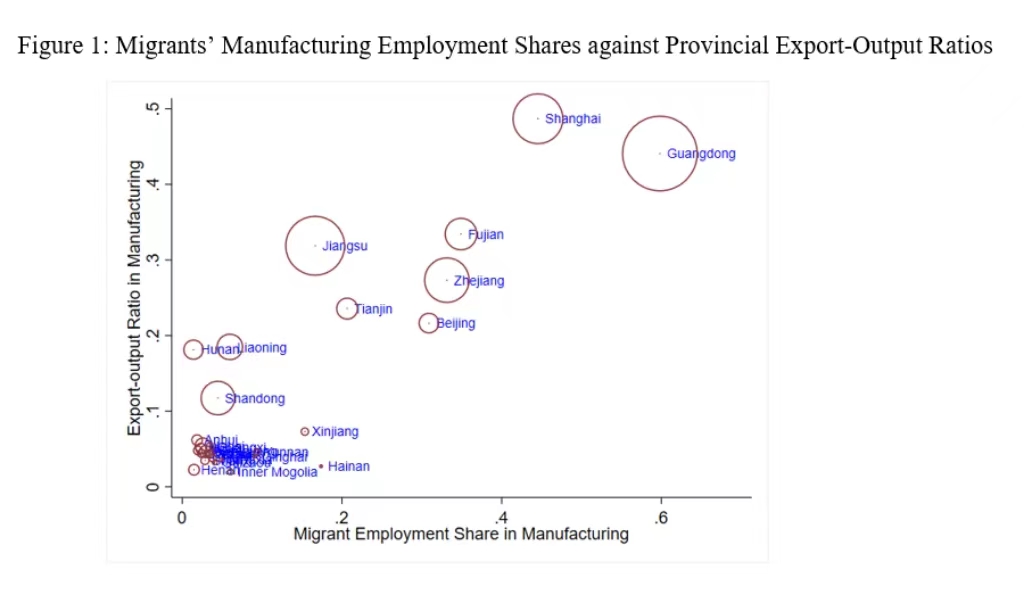Migration,Tariffs,and China’s Export Surge
China’s exports have increased dramatically in recent decades. We build a multi-sector spatial general equilibrium model and combine rich data sources to account for China’s export surge between 1990 and 2005 from three policy changes: China’s import tariffs, tariffs imposed on China’s exports, and barriers to internal migration in China. We find that the three policy changes jointly accounted for 30% of China’s export growth between 1990 and 2005 and that there is a positive interaction between tariff and migration policies.

The share of global trade of “Made in China” goods surged from 2% to 15% between 1990 and 2021, effectively establishing China as a dominant force in world manufacturing trade. While a large body of literature has focused on the consequences of China’s exports (see Autor, Dorn, and Hanson 2016 for a review), few papers have examined the causes of China’s export surge. In this paper, we jointly quantify the relative contributions of China’s migration and tariff policies to China’s export surge.
Migrant Employment and Manufacturing Exports
Due to data limitations, our analysis focuses on the 1990–2005 period. The starting point of our paper is the observation that China’s internal migrants make up an important portion of manufacturing employment. We study inter-provincial migrants—individuals whose Hukou is not registered in the province where they are currently working. For the broad manufacturing sector, Figure 1 plots migrants’ employment shares against export-output ratios across provinces, according to the 2005 mini census. Provinces where migrants comprised larger portions of manufacturing employment were more export oriented and had higher export volumes (reflected by the circle size). Notably, in Guangdong and Shanghai, migrants accounted for 60% and 45% of provincial manufacturing employment, respectively.

While we use the quantitative model to analyze the effect of migration shocks on China’s export surge, we initially provide evidence on the potential mechanisms by which migration facilitated export growth. We find two potential mechanisms. First, migration expanded employment in more productive provinces and sectors, which caused an aggregate output gain (Tombe and Zhu 2019; Hao, Sun, Tombe, and Zhu 2020). Second, employment expanded more in export-oriented provinces and sectors, which raised China’s aggregate export/output ratio.
We illustrate these potential channels with a back-of-the-envelope calculation based on a simple model. Consider a counterfactual economy in which we set migrant employment in province and sector to the level of year 1990. We keep output and exports per worker as fixed in each province and sector according to production and customs data in 2005. We decompose the impact of migrant employment on aggregate export growth as:

Given the migration shock between 1990 and 2005, our calculation shows a 1.07 p.p. increase in annual output growth and a 1.5 p.p. increase in annual growth of the export/output ratio. The gain in aggregate export intensity (which increased from 20% to 25% due to the migration shock) is because migration expanded employment in places that were more export oriented, as shown in Figure 1.
The simple calculation above overlooks several economic forces. First, we ignore the general equilibrium wage adjustments of increasing sectoral labor supply and the consequent adjustments of the province-sector-level export intensity. Second, our calculation treats labor as the only factor and ignores intermediate materials and the input-output linkages across sectors. Third, changes in economic policies (migration and tariff) could change firms’ market access to consumers and affect firm decisions about where to produce. Previous literature argues that the massive entry of new firms has been an important source of China’s productivity (Brandt, Van Biesebroeck, and Zhang 2012) and export growth (Khandelwal, Schott, and Wei 2013). Thus, we need a general equilibrium model that incorporates these factors to account for the impact of migration on China’s exports.
Quantitative Model
Our model has three key components. First, we build on the work of Arkolakis, Ramondo, Rodríguez-Clare, and Yeaple (2018) to model firm location and export regime (ordinary or processing) choices, with correlated productivity draws from a multivariate Pareto distribution (Arkolakis, Rodríguez-Clare, and Su 2016). The second is the inter-sectoral input-output linkages (Caliendo and Parro 2015). Third, Chinese workers with heterogeneous location preferences and migration costs sort into provinces and sectors. A policy shock could impact the aggregate exports not only by affecting firms’ decision on whether and how much to export (Chaney 2008), but also by changing firms’ decision on where to produce and their processing or ordinary regime choice. The aggregate trade elasticity, therefore, depends on the two structural parameters of productivity correlation across locations and across regimes, which, respectively, govern firm location and regime responses to policy shocks.
Quantitative Findings
Using the calibrated model, we first evaluate the export impact of each individual policy shock. We do so by taking each shock into the model, one at a time. Table 1 shows that the reduction in migration costs led to a 1.29 p.p. increase in annual export growth rate, accounting for 7.2% of the overall export growth during this period. The reduction in import tariffs caused a 2.25 p.p. increase in annual export growth rate and accounted for 12.6% of the overall export growth. The changes in export tariffs resulted in a 1.37 p.p. increase in annual export growth and accounted for 7.7% of overall export growth.

Because the reductions in migration costs caused China to be more export oriented, the country is able to enjoy faster export growth from opening to trade. This suggests a potential positive interaction effect of migration and trade policies. To this end, we evaluate the joint effects of three policies, in which we simultaneously incorporate the three policy changes in the model. Table 2 reports a joint effect of 5.27 p.p., which accounted for 30% of China’s export surge between 1990 and 2005. Interestingly, the joint effect is larger than the aggregation of individual effects, which total 4.91 p.p. The latter is computed based on Table 1. The comparison indicates a positive interaction of tariff and migration policy, which contributed to 0.36 p.p. annual export growth. This interaction effect would have been missing if we analyzed migration and tariffs separately.

This positive interaction can be generated through three possible mechanisms in our model. The first is comparative advantage: even if the decrease in migration costs were similar across provinces and sectors, the same change in migration costs would have led to a larger change in the relative supply of workers in export-oriented provinces and sectors, because migrants accounted for a higher employment share in these provinces and sectors (due to geographic proximity or comparative advantage). The second is that migration costs decreased more in export-oriented provinces (similarly across sectors). Third, migration costs were reduced more in export-oriented industries. We find that the first channel is the primary driver.
In our final exercise, we study the role of firm and worker adjustments in China’s export growth. We find that, in a model where firms’ location and regime do not respond to policy changes, the joint effects of policies on export growth drop by nearly half; and in a model where workers do not adjust across locations or sectors, the export impacts of tariffs drop by 12%. Accounting for equilibrium adjustments of workers and firms is quantitatively important for evaluating China’s export growth.
References
Arkolakis, Costas, Natalia Ramondo, Andrés Rodríguez-Clare, and Stephen Yeaple. 2018. “Innovation and Production in the Global Economy.” American Economic Review 108 (8): 2128–73. https://doi.org/10.1257/aer.20141743.
Arkolakis, Costas, Andrés Rodríguez-Clare, and Jiun-Hua Su. 2016. “A Multivariate Distribution with Pareto Tails.” Working paper.
Autor, David H., David Dorn, and Gordon H. Hanson. 2016. “The China Shock: Learning from Labor-Market Adjustment to Large Changes in Trade.” Annual Review of Economics 8: 205–40. https://doi.org/10.1146/annurev-economics-080315-015041.
Brandt, Loren, Johannes Van Biesebroeck, and Yifan Zhang. 2012. “Creative Accounting or Creative Destruction? Firm-Level Productivity Growth in Chinese Manufacturing.” Journal of Development Economics 97 (2): 339–51. https://doi.org/10.1016/j.jdeveco.2011.02.002.
Caliendo, Lorenzo, and Fernando Parro. 2015. “Estimates of the Trade and Welfare Effects of NAFTA.” Review of Economic Studies 82 (1): 1–44. https://doi.org/10.1093/restud/rdu035.
Chaney, Thomas. 2008. “Distorted Gravity: The Intensive and Extensive Margins of International Trade.” American Economic Review 98 (4): 1707–21. https://doi.org/10.1257/aer.98.4.1707.
Hao, Tongtong, Ruigi Sun, Trevor Tombe, and Xiaodong Zhu. 2020. “The Effect of Migration Policy on Growth, Structural Change, and Regional Inequality in China.” Journal of Monetary Economics 113: 112–34. https://doi.org/10.1016/j.jmoneco.2020.03.003.
Khandelwal, Amit K., Peter K. Schott, and Shang-Jin Wei. 2013. “Trade Liberalization and Embedded Institutional Reform: Evidence from Chinese Exporters.” American Economic Review 103 (6): 2169–95. https://doi.org/10.1257/aer.103.6.2169.
Tombe, Trevor, and Xiaodong Zhu. 2019. “Trade, Migration, and Productivity: A Quantitative Analysis of China.” American Economic Review 109 (5): 1843–72. https://doi.org/10.1257/aer.20150811.

Latest
Most Popular
- VoxChina Covid-19 Forum (Second Edition): China’s Post-Lockdown Economic Recovery VoxChina, Apr 18, 2020
- China’s Joint Venture Policy and the International Transfer of Technology Kun Jiang, Wolfgang Keller, Larry D. Qiu, William Ridley, Feb 06, 2019
- China’s Great Housing Boom Kaiji Chen, Yi Wen, Oct 11, 2017
- Wealth Redistribution in the Chinese Stock Market: the Role of Bubbles and Crashes Li An, Jiangze Bian, Dong Lou, Donghui Shi, Jul 01, 2020
- The Dark Side of the Chinese Fiscal Stimulus: Evidence from Local Government Debt Yi Huang, Marco Pagano, Ugo Panizza, Jun 28, 2017
- What Is Special about China’s Housing Boom? Edward L. Glaeser, Wei Huang, Yueran Ma, Andrei Shleifer, Jun 20, 2017
- Privatization and Productivity in China Yuyu Chen, Mitsuru Igami, Masayuki Sawada, Mo Xiao, Jan 31, 2018
- How did China Move Up the Global Value Chains? Hiau Looi Kee, Heiwai Tang, Aug 30, 2017
- Evaluating Risk across Chinese Housing Markets Yongheng Deng, Joseph Gyourko, Jing Wu, Aug 02, 2017
- China’s Shadow Banking Sector: Wealth Management Products and Issuing Banks Viral V. Acharya, Jun Qian, Zhishu Yang, Aug 09, 2017




 Facebook
Facebook  Twitter
Twitter  Instagram
Instagram WeChat
WeChat  Email
Email 


